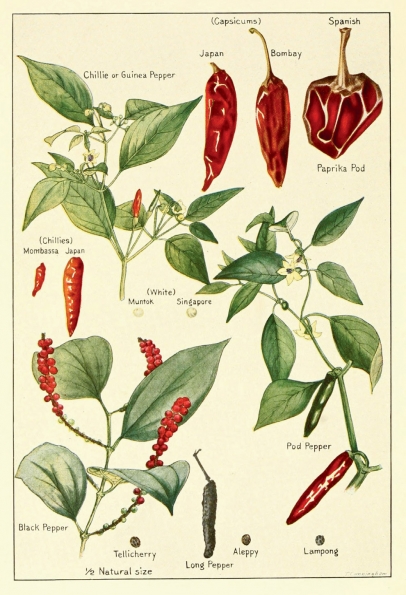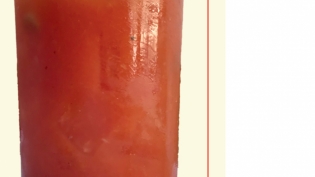In The Garden: Some Like it Hot
I can’t recall if we decided to go to Spain in 2006 because we had a bumper crop of Padron peppers the year before or if we grew Padron peppers to practice preparing and eating tapas on our vacation! Padron is a famous Spanish heirloom pepper that is served across the Iberian Peninsula simply sautéed in olive oil and sprinkled with a little coarse sea salt. The interesting thing about Padron is that it is generally a mild pepper if harvested small but one in 20 packs some heat, so eating a plate of Padron peppers could go either way.
I got addicted to the heat of Padron that summer before Spain. I would leave the peppers on the plant a little longer to increase my chances of getting some heat. Hot peppers do, in fact, get hotter the more they ripen to red. And, interestingly, sweet bell peppers actually get sweeter as they ripen from green to red, yellow, orange or purple. It’s like age allows you to reach your full, intended potential if you are a pepper.
There are two ways to categorize a pepper: by heat and by shape. In 1912, Wilbur Scoville developed a test to measure the heat in a pepper. According to his scale a sweet bell pepper rates 0 Scoville units and a Carolina Reaper comes in at a whopping 2,200,000 (yes, 2.2 million) units. Guinness rates the Carolina Reaper as the hottest pepper in the world.
Not everyone is quite ready for that so if you are looking for a hot pepper try a variety of Thai chili or habanero that range from 8,000 to 60,000 units; or jalapeño, serrano and cayenne that range from 5,000 to 60,000 units. It seems that the smaller the pepper the more concentrated the heat. Plus, most of the heat is found in the capsaicin-laced pithy membranes inside the pepper so by paring out (or not) these ribs you can reduce the heat a little. And, for the kind of chili heat that will not blow your head off (with a Scoville rating of 1,000–8,000) try growing a banana pepper, Anaheim or poblano variety.
Largely, growing peppers is easy if you have well-drained soil and full sun. There are a few rules to follow, however, if you want a bumper crop of habaneros or jalapeños. First, understand that peppers like it warm and will grow and produce when temperatures are between 65° and 85°. Blossom-drop may occur when temperatures drop below 58° or go over 90°. In this case just be patient.
About 50 years ago a fungus was discovered in pepper crops in New York and it has since spread as far as California and Florida. It’s in our midst, as well. The fungus in question causes phytophthora blight in peppers. Some refer to the sudden wilting of peppers as damping off, phytophthora root rot, crown rot or stem and fruit rot. Phytophthora blight attacks all parts of the plant and usually becomes apparent as the plant begins to fruit, mid-season, and when the weather becomes hot and plant stress increases. You may see spots on the foliage or lesions on the stem. Fruit may develop water-soaked spots and turn moldy. The seeds inside become infected, as well, so do not save seed from infected plants.
If you have had pepper blight in the past it is likely that the fungus continues to exist in your garden soil. The fungal spores can spread far and wide by wind and water so it may be difficult to control in the average backyard garden by simple crop rotation. Plus, the fungus has various hosts including eggplant, tomatoes and cucurbits (cucumbers, squash and melons).
Anthracnose can destroy a pepper crop, too. Anthracnose infects many garden vegetables and it is a great deal more serious than many of the other disease problems because it is hard to eliminate from the garden. The fungus is spread by cucumber beetles, splashing water and infected tools. The obvious characteristics of anthracnose include circular lesions, often appearing as sunken, water-soaked holes with a blackened edge. Signs may appear on both foliage and fruit. For peppers, anthracnose can spread quickly and renders the plant and crop worthless.
Although not a disease, sunscald is another common problem with peppers. It is the result of inadequate foliage shading the peppers (disease is usually the culprit in causing foliage to drop, however). Sunscald, evidenced by a whitish spot that begins to blacken and then rot, is unavoidable if there is not enough foliage to shade the fruit. Try to maintain healthy plants by understanding their needs.
Be mindful not to over-fertilize leafy vegetables that bear fruit. High-nitrogen fertilizers stimulate foliage growth and we want flower and fruit production, not just lush foliage. Organic fertilizers often provide the best, slow-release nutrients to our plants to maintain healthy growth throughout the season. Compost is also useful because it will slowly feed the plant and improve soil tilth and drainage. Peppers particularly like phosphorus for bloom (a good source is bone meal or rock phosphate worked into the hole at planting time) and calcium (a source for this is dolomitic limestone), which prevents blossom-end-rot and helps to build the walls of the fruit. If you have ever grown a thin-skinned, bitter green pepper you know what a lack of calcium looks and tastes like in a pepper.
The spread of disease is favored by wet, warm weather, but these are things we have very little control over. Considering all the things that can go wrong in the garden I think that we cannot overestimate the power of good cultural practices for all of our crops that share the garden space. Do it right from the beginning, amending the soil to improve drainage and fertility; if this seems impossible then build a series of raised beds. Keep the garden clean, removing diseased debris quickly and managing the weed-to-plant ratio. Try to keep soil moisture moderated, use soaker hoses, don’t over-fertilize and get mulch down as early in the season as you can manage, and purchase certified seed. And, if all else fails forgo planting peppers for a couple of years and keep an eye on your tomatoes … if they stay healthy then maybe the peppers can come back to the garden.
Jeneen Wiche teaches at the University of Louisville and raises Kentuckygrazed lamb, poultry and eggs at Swallow Rail farm in Shelby County with her husband, Andy Smart.







